Predicting Emotional Experiences through Eye-Tracking: A Study of Tourists’ Responses to Traditional Village Landscapes
Abstract
:1. Introduction
2. Related Works
3. Research Methodology and Experimental Design
- (1)
- What are the relationships between eye-tracking metrics (APD, ANS, TDF, FC) and tourists’ emotional experiences (positive, neutral, and negative) in the context of traditional village landscapes?
- (2)
- How do the interactions between tour phases (entry, core, and departure) and landscape types (historical, architectural, economic, and life) influence eye-tracking metrics and, consequently, emotional experiences?
- (3)
- Can a prediction model be developed using eye-tracking data and machine learning techniques to accurately capture and predict the dynamic emotional responses of tourists to cultural landscapes, ultimately contributing to sustainable village development and enhanced visitor experiences?
3.1. Study Area
3.2. Experimental Design
3.2.1. Stimuli
3.2.2. Participants
3.2.3. Procedure
3.2.4. Data Processing and Analysis
4. Results
4.1. Eye-Tracking Metrics across Different Phases and Landscape Types
4.2. Eye-Tracking Metrics in Each Phases and Landscape Types
4.3. Correlation Testing between Eye-Tracking Experiment Data and Emotional Evaluation
4.4. Landscape-Specific Emotional Prediction Models
4.4.1. Historic Landscapes and Positive Emotional Prediction
4.4.2. Architectural Landscapes and Neutral Emotional Prediction
4.4.3. Economic Landscapes and Negative Emotional Prediction
4.5. Model Validation Test
5. Discussion
5.1. Advancing Eye-Tracking and Emotion Prediction in Tourism
5.2. Implications for Cultural Landscape Planning and Tourism Design
5.3. Limitations and Future Research Directions
6. Conclusions
Supplementary Materials
Author Contributions
Funding
Institutional Review Board Statement
Informed Consent Statement
Data Availability Statement
Conflicts of Interest
References
- Gao, X.; Li, Z.; Sun, X. Relevance between Tourist Behavior and the Spatial Environment in Huizhou Traditional Villages—A Case Study of Pingshan Village, Yi County, China. Sustainability 2023, 15, 5016. [Google Scholar] [CrossRef]
- Zhou, J.; Wu, S.; Wu, X.; Xia, X. Cultural Landscape Perception of the Chinese Traditional Settlement: Based on Tourists’ Online Comments. PLoS ONE 2023, 18, e0283335. [Google Scholar] [CrossRef] [PubMed]
- Cheng, T.-M.C.; Wu, H.; Huang, L.-M. The Influence of Place Attachment on the Relationship between Destination Attractiveness and Environmentally Responsible Behavior for Island Tourism in Penghu, Taiwan. J. Sustain. Tour. 2013, 21, 1166–1187. [Google Scholar] [CrossRef]
- Li, X.; Wang, C. Understanding the Relationship between Tourists’ Perceptions of the Authenticity of Traditional Village Cultural Landscapes and Behavioural Intentions, Mediated by Memorable Tourism Experiences and Place Attachment. Asia Pac. J. Tour. Res. 2023, 28, 254–273. [Google Scholar] [CrossRef]
- Rao, Y.; Lu, N.; Yokoya, N.; Nakazawa, S.; Matsuki, T.; Iwasaki, A.; Muñoz-Pedreros, A.; Moncada-Herrera, J.; Gómez-Cea, L.; Kim, J.; et al. Measuring Emotions in Real Time. J. Travel Res. 2015, 54, 419–429. [Google Scholar]
- Fukahori, K.; Kubota, Y.; Saeedi, I.; Dabbagh, E.; Deng, J.; Pierskalla, C. Impact of Past Experience on Perceived Value, Overall Satisfaction, and Destination Loyalty: A Comparison Between Visitor and Resident Attendees of a Festival. Event Manag. 2011, 15, 163–177. [Google Scholar]
- Junling, Z.; Yao, W. Traditional Village Rural Landscape Construction. In Proceedings of the 2019 IEEE Eurasia Conference on IOT, Communication and Engineering (ECICE), Yunlin, Taiwan, 3–6 October 2019; pp. 121–124. [Google Scholar]
- Kang, N.; Xie, G.; Liu, C. Assessment of Society’s Perceptions on Cultural Ecosystem Services in a Cultural Landscape in Nanchang, China. Sustainability 2023, 15, 10308. [Google Scholar] [CrossRef]
- Liu, W.; Wang, X.; Liu, W.; He, Y.; Li, P. Visual Perception of Traditional Village Landscape: An Eye Tracking Experiment. SHS Web Conf. 2023, 171, 03035. [Google Scholar] [CrossRef]
- Chen, G.; Sun, X.; Yu, W.; Wang, H. Analysis Model of the Relationship between Public Spatial Forms in Traditional Villages and Scenic Beauty Preference Based on LiDAR Point Cloud Data. Land 2022, 11, 1133. [Google Scholar] [CrossRef]
- Cai, Y.; Ding, R.; Li, Q. An Improved Geographic Modeling Method to the Vulnerability of the Traditional Village Architectural Landscape. In Proceedings of the International Conference on Geographic Information and Remote Sensing Technology (GIRST 2022), Kunming, China, 16–18 September 2022; SPIE: Bellingham, WA, USA, 2023; Volume 12552, pp. 171–177. [Google Scholar]
- Han, G.; Zhu, C. Research on Tourism Attraction, Tourism Experience Value Perception and Psychological Tendency of Traditional Rural Tourism Destinations. Int. J. Neuropsychopharmacol. 2022, 25, A72–A73. [Google Scholar] [CrossRef]
- Polyakova, M.A. Cultural Heritage: Actual Problems of Research and Preservation. Herit. Mod. Times 2023, 5, 135–143. [Google Scholar] [CrossRef]
- Özkan, N.; Fidan, U.; Zeytun, B.; Tiraş, G.; Hodoğlugil, A. Investigation of the External Stimuli Effect on Emotion with Biostatistics Methods. In Proceedings of the 2018 Medical Technologies National Congress (TIPTEKNO), Magusa, Cyprus, 8–10 November 2018; pp. 1–4. [Google Scholar]
- Lin, Z.; Wang, Y.; Ye, X.; Wan, Y.; Lu, T.; Han, Y. Effects of Low-Carbon Visualizations in Landscape Design Based on Virtual Eye-Movement Behavior Preference. Land 2022, 11, 782. [Google Scholar] [CrossRef]
- Hong, C.; Wang, J.; Wang, Y.; Ning, T.; Song, J.; Xiaodong, D. Research on Emotion Recognition of Eye Movement in Realistic Environment. In Proceedings of the Eighth International Conference on Electronic Technology and Information Science (ICETIS 2023), Dalian, China, 24–26 March 2023; SPIE: Bellingham, WA, USA, 2023; Volume 12715, pp. 702–707. [Google Scholar]
- Skaramagkas, V.; Giannakakis, G.; Ktistakis, E.; Manousos, D.; Karatzanis, I.; Tachos, N.; Tripoliti, E.; Marias, K.; Fotiadis, D.I.; Tsiknakis, M. Review of Eye Tracking Metrics Involved in Emotional and Cognitive Processes. IEEE Rev. Biomed. Eng. 2023, 16, 260–277. [Google Scholar] [CrossRef] [PubMed]
- Cohn, M.A.; Fredrickson, B.L.; Brown, S.L.; Mikels, J.A.; Conway, A.M. Happiness Unpacked: Positive Emotions Increase Life Satisfaction by Building Resilience. Emotion 2009, 9, 361–368. [Google Scholar] [CrossRef] [PubMed]
- Hendriks, K.; Stobbelaar, D.J.; van Mansvelt, J.D.; Lin, Y.; Kerstetter, D.; Nawijn, J.; Mitas, O. Changes in Emotions and Their Interactions with Personality in a Vacation Context. Tour. Manag. 2014, 40, 416–424. [Google Scholar]
- Mitas, O.; Yarnal, C.; Adams, R.; Ram, N. Taking a “Peak” at Leisure Travelers’ Positive Emotions. Leis. Sci. 2012, 34, 115–135. [Google Scholar] [CrossRef]
- Greener, S. Research Limitations: The Need for Honesty and Common Sense. Interact. Learn. Environ. 2018, 26, 567–568. [Google Scholar] [CrossRef]
- He, C.; Zhang, J.; Liu, D.; Cui, Y.; Zhang, Y. Research on Protection of Village Cultural Heritage Based on Residents’ Perception and Experience—A Case Study of Fengzhou Ancient Town, Nan’an City, Fujian Province. In Communications in Computer and Information Science; Stephanidis, C., Antona, M., Ntoa, S., Salvendy, G., Eds.; Springer Nature: Cham, Switzerland, 2023; pp. 426–439. [Google Scholar]
- Yang, Q. Research on the Changes in Cultural Landscape of Tourist-Type Traditional Chinese Villages from the Perspective of Cultural Memory: Taking Anzhen Village in Chongqing as an Example. Land 2023, 12, 816. [Google Scholar] [CrossRef]
- Mele, M.L.; Federici, S. Gaze and Eye-Tracking Solutions for Psychological Research. Cogn. Process 2012, 13, 261–265. [Google Scholar] [CrossRef]
- Just, M.A.; Carpenter, P.A. A Theory of Reading: From Eye Fixations to Comprehension. Psychol. Rev. 1980, 87, 329–354. [Google Scholar] [CrossRef]
- Margariti, K.; Hatzithomas, L.; Boutsouki, C. Implementing Eye Tracking Technology in Experimental Design Studies in Food and Beverage Advertising. In Consumer Research Methods in Food Science; Gómez-Corona, C., Rodrigues, H., Eds.; Springer: New York, NY, USA, 2023; pp. 293–311. ISBN 978-1-07-163000-6. [Google Scholar]
- Sevcenko, N.; Appel, T.; Ninaus, M.; Moeller, K.; Gerjets, P. Theory-Based Approach for Assessing Cognitive Load during Time-Critical Resource-Managing Human–Computer Interactions: An Eye-Tracking Study. J. Multimodal User Interfaces 2023, 17, 1–19. [Google Scholar] [CrossRef]
- Lobodenko, L.; Cheredniakova, A.; Shesterkina, L.; Kharitonova, O. Eye-Tracking Technologies in the Analysis of Environmental Advertising and Journalistic Texts Perception by Youth. In Proceedings of the 2023 Communication Strategies in Digital Society Seminar (ComSDS), Saint Petersburg, Russia, 12 April 2023; pp. 78–85. [Google Scholar]
- Martinez-Marquez, D.; Pingali, S.; Panuwatwanich, K.; Stewart, R.A.; Mohamed, S. Application of Eye Tracking Technology in Aviation, Maritime, and Construction Industries: A Systematic Review. Sensors 2021, 21, 4289. [Google Scholar] [CrossRef] [PubMed]
- Ulahannan, A.; Jennings, P.; Oliveira, L.; Birrell, S. Designing an Adaptive Interface: Using Eye Tracking to Classify How Information Usage Changes Over Time in Partially Automated Vehicles. IEEE Access 2020, 8, 16865–16875. [Google Scholar] [CrossRef]
- Dolcos, F.; Bogdan, P.C.; O’Brien, M.; Iordan, A.D.; Madison, A.; Buetti, S.; Lleras, A.; Dolcos, S. The Impact of Focused Attention on Emotional Evaluation: An Eye-Tracking Investigation. Emotion 2022, 22, 1088–1099. [Google Scholar] [CrossRef] [PubMed]
- Huang, G.; Li, Y.; Zhu, H.; Feng, H.; Shen, X.; Chen, Z. Emotional Stimulation Processing Characteristics in Depression: Meta-Analysis of Eye Tracking Findings. Front. Psychol. 2023, 13, 1089654. [Google Scholar] [CrossRef] [PubMed]
- Maiolino, R.; Scholtz, J.; Witstok, J.; Carniani, S.; D’Eugenio, F.; de Graaff, A.; Übler, H.; Tacchella, S.; Curtis-Lake, E.; Arribas, S.; et al. Visual Perception of Facial Emotional Expressions during Saccades. Behav. Sci. 2019, 9, 131. [Google Scholar] [CrossRef] [PubMed]
- Kashihara, K. Microsaccadic Modulation Evoked by Emotional Events. J. Physiol. Anthr. 2020, 39, 26. [Google Scholar] [CrossRef] [PubMed]
- Lim, J.Z.; Mountstephens, J.; Teo, J. Emotion Recognition Using Eye-Tracking: Taxonomy, Review and Current Challenges. Sensors 2020, 20, 2384. [Google Scholar] [CrossRef] [PubMed]
- Kret, M.E.; Roelofs, K.; Stekelenburg, J.J.; de Gelder, B. Emotional Signals from Faces, Bodies and Scenes Influence Observers’ Face Expressions, Fixations and Pupil-Size. Front. Hum. Neurosci. 2013, 7, 810. [Google Scholar] [CrossRef]
- Subramanian, R.; Shankar, D.; Sebe, N.; Melcher, D. Emotion Modulates Eye Movement Patterns and Subsequent Memory for the Gist and Details of Movie Scenes. J. Vis. 2014, 14, 31. [Google Scholar] [CrossRef]
- Qiu, S.; Zhao, H.; Jiang, N.; Wang, Z.; Liu, L.; An, Y.; Zhao, H.; Miao, X.; Liu, R.; Fortino, G. Multi-Sensor Information Fusion Based on Machine Learning for Real Applications in Human Activity Recognition: State-of-the-Art and Research Challenges. Inf. Fusion 2022, 80, 241–265. [Google Scholar] [CrossRef]
- Misthos, L.-M.; Krassanakis, V.; Merlemis, N.; Kesidis, A.L. Modeling the Visual Landscape: A Review on Approaches, Methods and Techniques. Sensors 2023, 23, 8135. [Google Scholar] [CrossRef]
- Huang, J.; Deng, Q.; Liang, H.; Tao, J.; Chen, G.; Sun, X.; Yu, W.; Wang, H. Cultural Landscape Characteristics and Zoning of Traditional Villages in Huizhou City. JCAU 2007, 5, 1311. [Google Scholar] [CrossRef]
- Zhang, M.; Shen, C.; Gu, W.; Chen, Q. Identification of Traditional Village Aggregation Areas from the Perspective of Historic Layering: Evidence from Hilly Regions in Zhejiang Province, China. Land 2023, 12, 2088. [Google Scholar] [CrossRef]
- Ma, L.; Wang, X. A Review of Eye-Tracking Technology Application in Tourism Research. In Proceedings of the 2023 5th International Conference on Economic Management and Cultural Industry (ICEMCI 2023); Cao, F., Singh, S.N., Jusoh, A., Mishra, D., Eds.; Atlantis Press International BV: Dordrecht, The Netherlands, 2024; Volume 276, pp. 838–846, ISBN 978-94-6463-367-2. [Google Scholar]
- Skaramagkas, V.; Ktistakis, E.; Manousos, D.; Kazantzaki, E.; Tachos, N.S.; Tripoliti, E.; Fotiadis, D.I.; Tsiknakis, M. eSEE-d: Emotional State Estimation Based on Eye-Tracking Dataset. Brain Sci. 2023, 13, 589. [Google Scholar] [CrossRef] [PubMed]
- Martínez-Soto, J.; de la Fuente Suárez, L.A.; Gonzáles-Santos, L.; Barrios, F.A. Observation of Environments with Different Restorative Potential Results in Differences in Eye Patron Movements and Pupillary Size. IBRO Rep. 2019, 7, 52–58. [Google Scholar] [CrossRef]
- Savin, G.-D.; Fleșeriu, C.; Batrancea, L. Eye Tracking and Tourism Research: A Systematic Literature Review. J. Vacat. Mark. 2022, 28, 285–302. [Google Scholar] [CrossRef]
- Fang, Q.; Li, Z. Cultural Ecology Cognition and Heritage Value of Huizhou Traditional Villages. Heliyon 2022, 8, e12627. [Google Scholar] [CrossRef] [PubMed]
- Bai, W.; Wang, J.; Wong, J.W.C.; Han, X.; Guo, Y. The Soundscape and Tourism Experience in Rural Destinations: An Empirical Investigation from Shawan Ancient Town. Humanit. Soc. Sci. Commun 2024, 11, 492. [Google Scholar] [CrossRef]
- James, G.; Witten, D.; Hastie, T.; Tibshirani, R. An Introduction to Statistical Learning: With Applications in R; Springer Science & Business Media: Berlin/Heidelberg, Germany, 2013; ISBN 978-1-4614-7138-7. [Google Scholar]
- Kimble, M.O.; Fleming, K.; Bandy, C.; Kim, J.; Zambetti, A. Eye Tracking and Visual Attention to Threating Stimuli in Veterans of the Iraq War. J. Anxiety Disord. 2010, 24, 293–299. [Google Scholar] [CrossRef]
- Wass, S.V.; Forssman, L.; Leppänen, J. Robustness and Precision: How Data Quality May Influence Key Dependent Variables in Infant Eye-Tracker Analyses. Infancy 2014, 19, 427–460. [Google Scholar] [CrossRef]
- Orquin, J.L.; Holmqvist, K. Threats to the Validity of Eye-Movement Research in Psychology. Behav. Res 2018, 50, 1645–1656. [Google Scholar] [CrossRef] [PubMed]
- Li, J.; Xu, L.; Tang, L.; Wang, S.; Li, L. Big Data in Tourism Research: A Literature Review. Tour. Manag. 2018, 68, 301–323. [Google Scholar] [CrossRef]
- Mauss, I.B.; Robinson, M.D. Measures of Emotion: A Review. Cogn. Emot. 2009, 23, 209–237. [Google Scholar] [CrossRef]
- Scott, N.; Green, C.; Fairley, S. Investigation of the Use of Eye Tracking to Examine Tourism Advertising Effectiveness. Curr. Issues Tour. 2016, 19, 634–642. [Google Scholar] [CrossRef]
- Wang, Y.; Sparks, B.A. An Eye-Tracking Study of Tourism Photo Stimuli. J. Travel Res. 2016, 55, 588–602. [Google Scholar] [CrossRef]
- Prayag, G.; Hosany, S.; Muskat, B.; Del Chiappa, G. Understanding the Relationships between Tourists’ Emotional Experiences, Perceived Overall Image, Satisfaction, and Intention to Recommend. J. Travel Res. 2017, 56, 41–54. [Google Scholar] [CrossRef]
- Nawijn, J. The Holiday Happiness Curve: A Preliminary Investigation into Mood during a Holiday Abroad. J. Tour. Res. 2010, 12, 281–290. [Google Scholar] [CrossRef]
- Nawijn, J.; Mitas, O.; Lin, Y.; Kerstetter, D. How Do We Feel on Vacation? A Closer Look at How Emotions Change over the Course of a Trip. J. Travel Res. 2013, 52, 265–274. [Google Scholar] [CrossRef]
- Franěk, M.; Šefara, D.; Petružálek, J.; Cabal, J.; Myška, K. Differences in Eye Movements While Viewing Images with Various Levels of Restorativeness. J. Environ. Psychol. 2018, 57, 10–16. [Google Scholar] [CrossRef]
- Dupont, L.; Antrop, M.; Van Eetvelde, V. Eye-Tracking Analysis in Landscape Perception Research: Influence of Photograph Properties and Landscape Characteristics. Landsc. Res. 2014, 39, 417–432. [Google Scholar] [CrossRef]
- Ode Sang, Å.; Knez, I.; Gunnarsson, B.; Hedblom, M. The Effects of Naturalness, Gender, and Age on How Urban Green Space Is Perceived and Used. Urban For. Urban Green. 2016, 18, 268–276. [Google Scholar] [CrossRef]
- Driver, J. A Selective Review of Selective Attention Research from the Past Century. Br. J. Psychol. 2001, 92, 53–78. [Google Scholar] [CrossRef]
- Sznajder, M.; Przezbórska, L.; Scrimgeour, F. Agritourism; CABI: Wallingford, UK, 2009; ISBN 978-1-84593-482-8. [Google Scholar]
- Rončák, M.; Scholz, P.; Linderová, I. Safety Concerns and Travel Behavior of Generation Z: Case Study from the Czech Republic. Sustainability 2021, 13, 13439. [Google Scholar] [CrossRef]

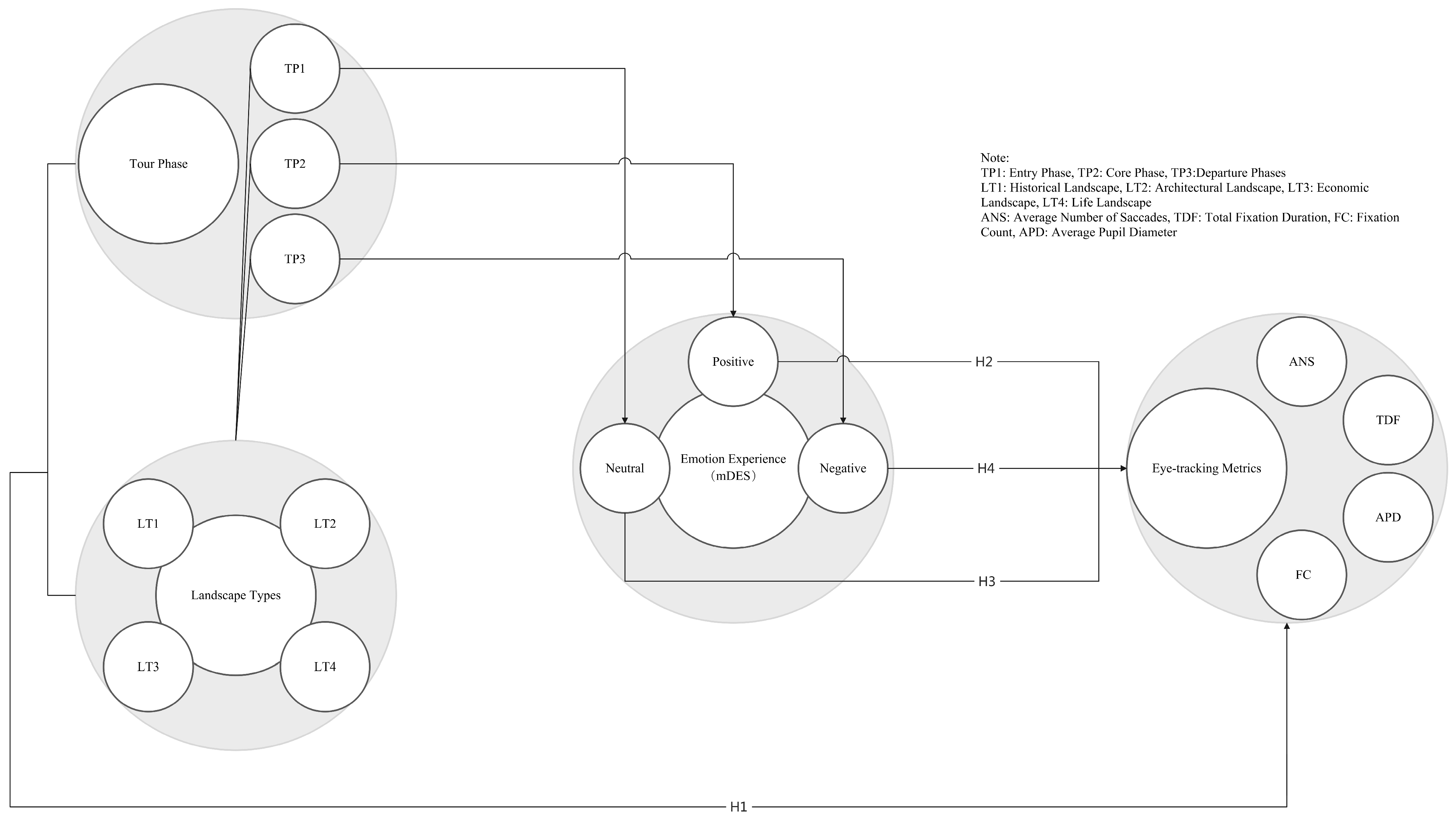
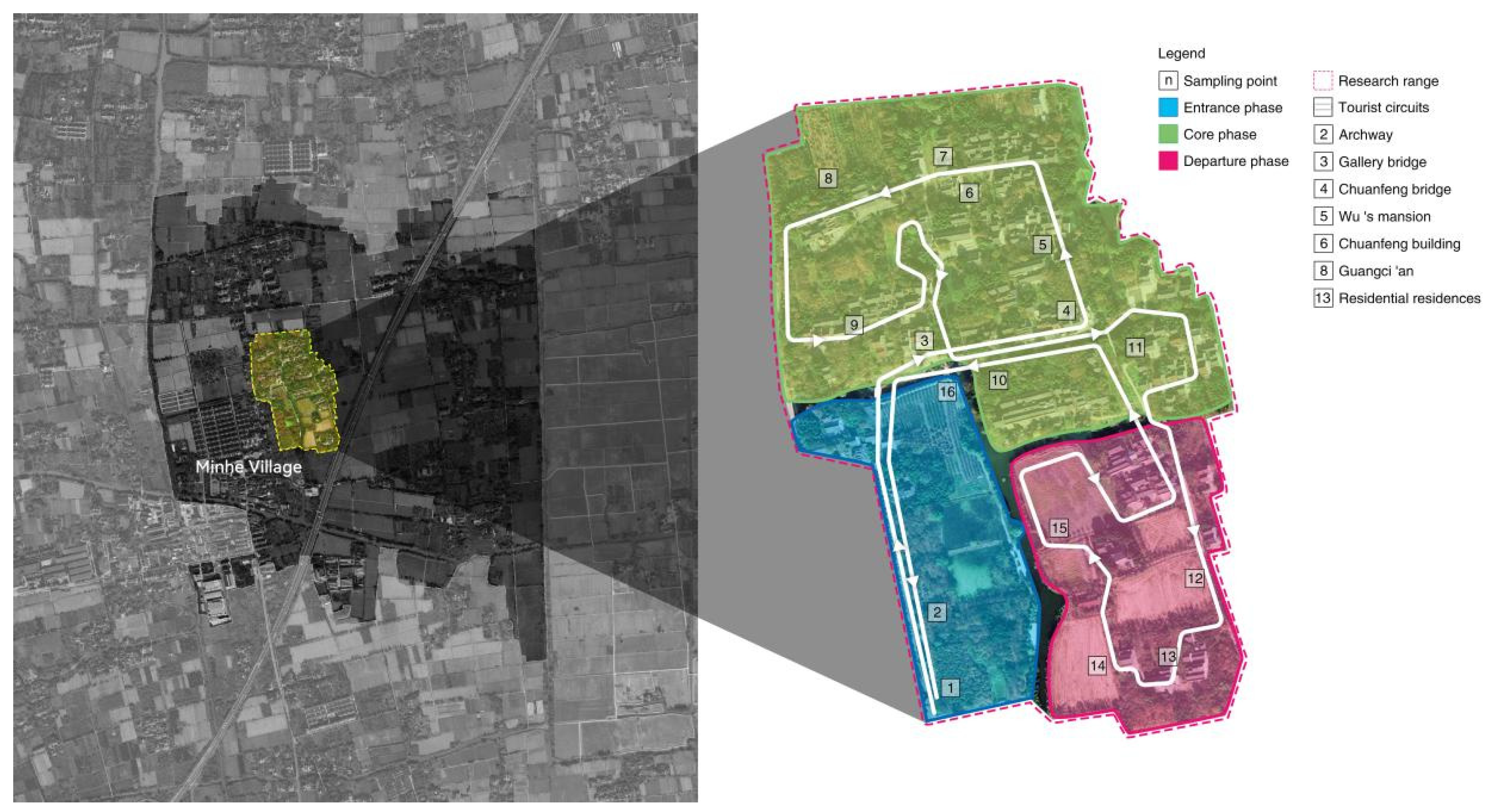
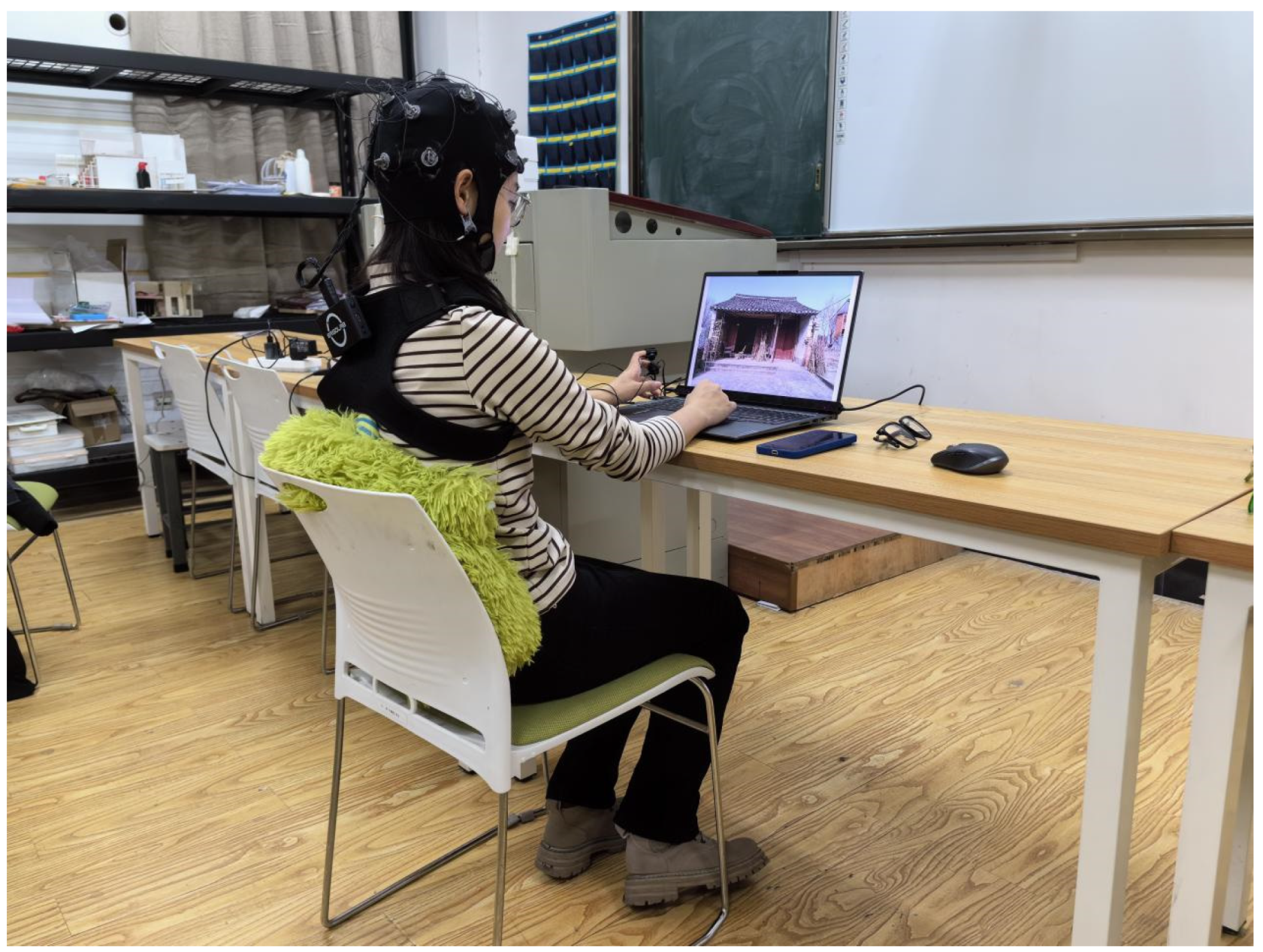
| Entry Phase | Core Phase | Departure Phases | |
|---|---|---|---|
| Historical Landscape |  | 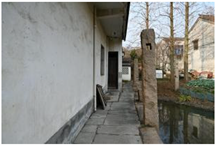 | 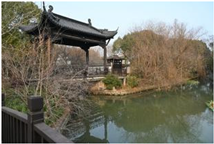 |
| Architectural Landscape | 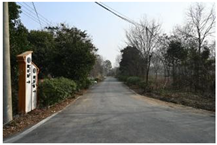 |  |  |
| Economic Landscape | 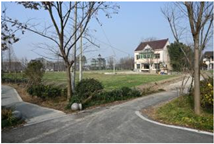 | 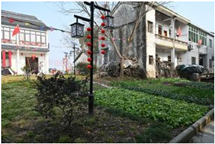 |  |
| Life Landscape |  |  | 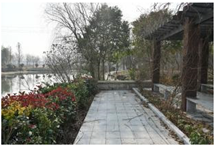 |
| Eye-Tracking Metrics | Meaning |
|---|---|
| Average Number of Saccades (ANS) | The number of times the observer gazes during a specific period of time. Generally, a higher number of gazes may indicate higher visual or cognitive processing demands. |
| Total Fixation Duration (TDF) | Total time observed by the observer. Reflects greater attractiveness or richer information for the observer. |
| Fixation Count (FC) | The number of times the observer gazes. Multiple gazes may indicate repeated attention from the observer. |
| APD | It is generally considered as an indicator of emotional arousal and cognitive load. An increase in pupil diameter is usually associated with high levels of emotional arousal or cognitive load. |
| Eye-Tracking Metrics | Effect | SS | df | MS | F | p | ηp2 |
|---|---|---|---|---|---|---|---|
| ANS | Tour Phase | 1.257 | 2 | 0.628 | 0.457 | 0.635 | 0.012 |
| Landscape Type | 27.503 | 3 | 9.168 | 6.556 | <0.001 *** | 0.144 | |
| Tour Phase × Landscape Type | 17.721 | 6 | 2.954 | 2.225 | 0.042 * | 0.054 | |
| TDF | Tour Phase | 0.152 | 2 | 0.076 | 0.756 | 0.473 | 0.019 |
| Landscape Type | 0.727 | 3 | 0.242 | 2.362 | 0.075 | 0.057 | |
| Tour Phase × Landscape Type | 1.769 | 6 | 0.295 | 2.494 | 0.023 * | 0.06 | |
| FC | Tour Phase | 21.975 | 2 | 10.988 | 4.521 | 0.014 * | 0.104 |
| Landscape Type | 9.495 | 3 | 3.165 | 1.269 | 0.288 | 0.032 | |
| Tour Phase × Landscape Type | 43.866 | 6 | 7.311 | 2.85 | 0.011 * | 0.068 | |
| APD | Tour Phase | 2.54 | 2 | 1.27 | 2.268 | 0.11 | 0.055 |
| Landscape Type | 13.231 | 3 | 4.41 | 7.46 | <0.001 *** | 0.161 | |
| Tour Phase × Landscape Type | 4.926 | 6 | 0.821 | 1.327 | 0.246 | 0.033 |
| ANS | TDF | |||||||||||||||||
|---|---|---|---|---|---|---|---|---|---|---|---|---|---|---|---|---|---|---|
| Entry Phase | Core Phase | Departure Phase | Entry Phase | Core Phase | Departure Phase | |||||||||||||
| M | SD | 95%CI | M | SD | 95%CI | M | SD | 95%CI | M | SD | 95%CI | M | SD | 95%CI | M | SD | 95%CI | |
| Architectural Landscapes | 3.18 | 1.22 | 2.791–3.57 | 2.83 | 1.1 | 2.474–3.179 | 3.29 | 1.03 | 2.961–3.621 | 0.60 | 0.33 | 0.496–0.709 | 0.76 | 0.31 | 0.656–0.856 | 0.69 | 0.36 | 0.577–0.804 |
| Historical Landscape | 3.23 | 1.27 | 2.825–3.635 | 2.56 | 1.06 | 2.219–2.896 | 2.78 | 1.25 | 2.383–3.182 | 0.68 | 0.39 | 0.557–0.807 | 0.78 | 0.32 | 0.682–0.884 | 0.70 | 0.33 | 0.593–0.806 |
| Economic Landscape | 2.43 | 1.11 | 2.074–2.781 | 2.67 | 1.31 | 2.25–3.086 | 2.51 | 1.17 | 2.138–2.888 | 0.65 | 0.33 | 0.544–0.754 | 0.55 | 0.27 | 0.466–0.639 | 0.67 | 0.35 | 0.562–0.787 |
| Life Landscape | 2.28 | 0.96 | 1.973–2.587 | 2.68 | 1.37 | 2.241–3.121 | 2.62 | 1.13 | 2.254–2.979 | 0.69 | 0.27 | 0.603–0.775 | 0.51 | 0.34 | 0.405–0.62 | 0.70 | 0.34 | 0.592–0.807 |
| F(6, 234) = 2.225, p < 0.05, ηp2 = 0.054 | F(6, 234) = 2.494, p < 0.05, ηp2 = 0.06 | |||||||||||||||||
| FC | APD | |||||||||||||||||
| Entry Phase | Core Phase | Departure Phase | Entry Phase | Core Phase | Departure Phase | |||||||||||||
| M | SD | 95%CI | M | SD | 95%CI | M | SD | 95%CI | M | SD | 95%CI | M | SD | 95%CI | M | SD | 95%CI | |
| Architectural Landscapes | 3.39 | 1.62 | 2.869–3.908 | 4.38 | 1.63 | 3.857–4.901 | 3.17 | 1.35 | 2.737–3.602 | 3.04 | 0.84 | 2.776–3.311 | 3.12 | 0.75 | 2.879–3.36 | 2.71 | 0.76 | 2.463–2.951 |
| Historical Landscape | 3.45 | 1.64 | 2.926–3.977 | 4.49 | 1.63 | 3.97–5.014 | 3.57 | 1.65 | 3.043–4.099 | 2.97 | 0.71 | 2.742–3.193 | 2.89 | 0.7 | 2.67–3.12 | 2.67 | 0.83 | 2.402–2.934 |
| Economic Landscape | 3.6 | 1.45 | 3.136–4.061 | 3.51 | 1.42 | 3.056–3.965 | 3.64 | 1.69 | 3.103–4.186 | 2.7 | 0.84 | 2.429–2.967 | 2.56 | 0.77 | 2.312–2.804 | 2.49 | 0.86 | 2.213–2.764 |
| Life Landscape | 3.26 | 1.77 | 2.69–3.823 | 3.31 | 1.35 | 2.883–3.746 | 3.77 | 1.89 | 3.164–4.376 | 2.5 | 0.73 | 2.265–2.733 | 2.54 | 0.59 | 2.351–2.726 | 2.68 | 0.79 | 2.43–2.938 |
| F(6, 234) = 2.85, p < 0.05, ηp2 = 0.068 | / | |||||||||||||||||
| Positive Emotions | Negative Emotions | Neutral Emotions | |||||||||||
|---|---|---|---|---|---|---|---|---|---|---|---|---|---|
| Eye-Tracking Metrics | ANS | TDF | FC | APD | ANS | TDF | FC | APD | ANS | TDF | FC | APD | |
| Entry Phase | Architectural Landscapes | 0.041 | −0.083 | −0.159 | 0.232 | 0.348 * | 0.179 | 0.035 | −0.044 | −0.08 | 0.028 | −0.02 | −0.086 |
| Historic Landscapes | −0.221 | 0.073 | −0.197 | 0.527 ** | −0.08 | −0.077 | 0.044 | 0.118 | −0.183 | 0.003 | 0.143 | 0.033 | |
| Economic Landscapes | −0.07 | 0.069 | −0.062 | −0.193 | −0.242 | 0.046 | 0.198 | −0.079 | −0.256 | 0.348 * | 0.013 | −0.02 | |
| Life Landscapes | 0.161 | −0.034 | 0.315 * | 0.054 | 0.109 | −0.092 | −0.181 | −0.021 | 0.078 | −0.086 | −0.054 | 0.21 | |
| Core Phase | Architectural Landscapes | −0.053 | 0.141 | −0.175 | −0.125 | 0.035 | −0.197 | −0.676 ** | −0.13 | −0.237 | −0.18 | 0.016 | −0.218 |
| Historic Landscapes | −0.589 ** | 0.605 ** | 0.147 | 0.447 ** | 0.051 | 0.037 | −0.033 | 0.038 | 0.082 | −0.175 | −0.322 * | −0.212 | |
| Economic Landscapes | 0.093 | −0.048 | 0.173 | −0.023 | −0.065 | 0.198 | −0.328 * | −0.022 | 0.534 ** | 0.207 | −0.648 ** | −0.449 ** | |
| Life Landscapes | 0.058 | −0.343 * | 0.078 | −0.079 | 0.08 | −0.181 | −0.111 | −0.249 | −0.167 | −0.057 | −0.196 | −0.119 | |
| Departure Phase | Architectural Landscapes | −0.149 | −0.148 | 0.097 | 0.033 | 0.06 | −0.073 | 0.039 | −0.205 | 0.238 | 0.212 | 0.142 | −0.243 |
| Historic Landscapes | −0.268 | −0.064 | 0.279 | 0.182 | 0.052 | 0.112 | −0.126 | 0.267 | 0.146 | −0.277 | −0.268 | 0.085 | |
| Economic Landscapes | −0.179 | −0.164 | −0.086 | −0.02 | 0.146 | −0.095 | −0.395 * | 0.016 | 0.226 | −0.087 | −0.138 | −0.329 * | |
| Life Landscapes | 0.069 | 0.126 | 0.07 | 0.066 | 0.056 | −0.027 | −0.052 | 0.087 | −0.258 | 0.06 | 0.058 | 0.093 | |
| Stepwise | B | SE B | β | t | p | |
|---|---|---|---|---|---|---|
| 1 | Constant | 2.346 | 0.252 | 9.322 | <0.001 *** | |
| kTFD | 1.398 | 0.298 | 0.605 | 4.683 | <0.001 *** | |
| 2 | Constant | 3.38 | 0.348 | 9.701 | <0.001 *** | |
| kTFD | 1.078 | 0.27 | 0.466 | 3.986 | <0.001 *** | |
| kANS | −0.306 | 0.081 | −0.443 | −3.787 | 0.001 ** | |
| 3 | Constant | 2.312 | 0.325 | 7.122 | <0.001 *** | |
| kTFD | 0.735 | 0.211 | 0.318 | 3.479 | 0.001 *** | |
| kANS | −0.36 | 0.061 | −0.521 | −5.882 | <0.001 *** | |
| eAPD | 0.496 | 0.09 | 0.479 | 5.503 | <0.001 *** | |
| 4 | Constant | 1.417 | 0.213 | 6.66 | <0.001 *** | |
| kTFD | 0.505 | 0.124 | 0.219 | 4.076 | <0.001 *** | |
| kANS | −0.417 | 0.036 | −0.604 | −11.702 | <0.001 *** | |
| eAPD | 0.475 | 0.052 | 0.459 | 9.186 | <0.001 *** | |
| kAPD | 0.444 | 0.051 | 0.427 | 8.644 | <0.001 *** |
| Stepwise | B | SE B | β | t | p | |
|---|---|---|---|---|---|---|
| 1 | Constant | 4.602 | 0.307 | 14.985 | <0.001 *** | |
| kFC | −0.372 | 0.066 | −0.676 | −5.659 | <0.001 *** | |
| 2 | Constant | 3.761 | 0.359 | 10.467 | <0.001 *** | |
| kFC | −0.379 | 0.058 | −0.688 | −6.571 | <0.001 *** | |
| eANS | 0.274 | 0.077 | 0.37 | 3.533 | 0.001 *** | |
| 3 | Constant | 4.904 | 0.384 | 12.764 | <0.001 *** | |
| kFC | −0.404 | 0.047 | −0.733 | −8.602 | <0.001 *** | |
| eANS | 0.349 | 0.065 | 0.472 | 5.391 | <0.001 *** | |
| lAPD | −0.471 | 0.104 | −0.4 | −4.544 | <0.001 *** |
| Stepwise | B | SE B | β | t | p | |
| 1 | (Constant) | 4.888 | 0.353 | 13.863 | <0.001 *** | |
| kFC | −0.489 | 0.093 | −0.648 | −5.248 | <0.001 *** | |
| 2 | (Constant) | 3.719 | 0.311 | 11.953 | <0.001 *** | |
| kFC | −0.497 | 0.066 | −0.659 | −7.552 | <0.001 *** | |
| kANS | 0.449 | 0.072 | 0.546 | 6.262 | <0.001 *** | |
| 3 | (Constant) | 4.719 | 0.329 | 14.354 | <0.001 *** | |
| kFC | −0.495 | 0.053 | −0.656 | −9.396 | <0.001 *** | |
| kANS | 0.449 | 0.057 | 0.547 | 7.836 | <0.001 *** | |
| lAPD | −0.405 | 0.087 | −0.325 | −4.661 | <0.001 *** | |
| 4 | (Constant) | 5.865 | 0.25 | 23.498 | <0.001 *** |
| Tested Model | Average Scores | Model Predicted Scores | Score Difference |
|---|---|---|---|
| Model (1) | 3.412 | 3.173 | 0.239 |
| Model (2) | 3.417 | 3.265 | 0.152 |
| Model (3) | 3.521 | 3.092 | 0.429 |
Disclaimer/Publisher’s Note: The statements, opinions and data contained in all publications are solely those of the individual author(s) and contributor(s) and not of MDPI and/or the editor(s). MDPI and/or the editor(s) disclaim responsibility for any injury to people or property resulting from any ideas, methods, instructions or products referred to in the content. |
© 2024 by the authors. Licensee MDPI, Basel, Switzerland. This article is an open access article distributed under the terms and conditions of the Creative Commons Attribution (CC BY) license (https://creativecommons.org/licenses/by/4.0/).
Share and Cite
Ye, F.; Yin, M.; Cao, L.; Sun, S.; Wang, X. Predicting Emotional Experiences through Eye-Tracking: A Study of Tourists’ Responses to Traditional Village Landscapes. Sensors 2024, 24, 4459. https://doi.org/10.3390/s24144459
Ye F, Yin M, Cao L, Sun S, Wang X. Predicting Emotional Experiences through Eye-Tracking: A Study of Tourists’ Responses to Traditional Village Landscapes. Sensors. 2024; 24(14):4459. https://doi.org/10.3390/s24144459
Chicago/Turabian StyleYe, Feng, Min Yin, Leilei Cao, Shouqian Sun, and Xuanzheng Wang. 2024. "Predicting Emotional Experiences through Eye-Tracking: A Study of Tourists’ Responses to Traditional Village Landscapes" Sensors 24, no. 14: 4459. https://doi.org/10.3390/s24144459







